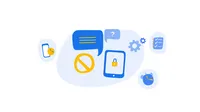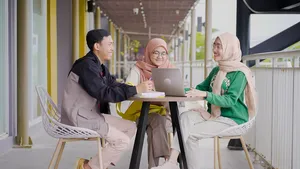When should you talk to kids about online safety?

Parenting today involves raising kids who are surrounded by technology and smartphones. As a mother of two young kids, making sure they understand online safety is a top priority of mine. Children are spending more time than ever looking at screens, and at younger ages. Finding that balance of online and offline, setting boundaries, and having those conversations are critical for creating a healthy and safer experience online.
A few clicks in the right direction...
Over the past two years, we’ve checked in with parents across the Asia Pacific region to see how they handle their kids’ technology usage. The survey results are encouraging: most parents (80%) are confident that their child would come to them with any problems online, and have already had conversations with them about online safety (73%).
Screentime has been steadily rising - and unsurprisingly, more than 60% of parents allowed increased screen time for kids, which has been essential for online classes (52%), learning new languages (33%) or even reading a book (31%).
… but not all compute.
Despite the optimism, one in three parents still worry their children might not be sufficiently informed about online safety. We also found that while children get their first mobile phone at an average age of 10, parents don’t talk to them about online safety until an average age of 13. This three-year gap could be why kids aren’t as informed as they could be— particularly at an age when they are most vulnerable to pitfalls and hard-to-break habits.
Never too early to learn
Parents believed having a casual conversation with their child (42%) was the most effective way to engage them on online safety, followed by establishing rules by using parental control features (30%). We also asked parents at Google about their own parenting tips.
“Being a mother of two, aged 10 and 13, I think what makes your house rules effective is having conversations with your kids and setting goals together, instead of a top-down approach. Google’s Family Link and SafeSearch are must-have tools to manage app usage and screen time, and to filter unsafe content. I also want to build their ability to make better decisions and understand consequences for their choices, as parents cannot always be by their side 24/7. That’s why it’s more important than ever to have ongoing conversations about online safety and how the internet works at home.” - Megumi Hitomi, Japan (Regional Lead of our Asia Pacific Parents & Caregivers at Google group)
“While my 7-year old daughter Mouse was playing her favorite game online, a stranger wanted to ‘share a gift’ in exchange for her password. It was a good thing we have regular conversations with our kids on online safety and privacy, because Mouse knew that sharing her password is a big no-no! She quickly showed me the message and laughed at how the stranger was trying to ‘fool’ her. Be Internet Awesome (BIA) has helped make this topic easier for children to understand and apply in their daily lives.” - Yves Gonzalez, The Philippines
“My children are 11, 8 and 6. I have seen them benefit a lot from time online. They often access content that helps them learn and explore, such as apps that allow them to do drawing challenges where they try new techniques, have their work rated by peers, and rate and give feedback on other players' work. This helps develop their analytical skills and creativity. As a parent, I’m also aware of the potential risks and try to actively manage screen time and use the parental control settings to keep my children safer online.” - Ruth Beattie, Singapore (SG chapter lead of our Asia Pacific Parents & Caregivers at Google group)
“‘5 more minutes!’ That's the phrase I once heard from my 6-year old son who likes playing online games on the weekends. While there are some great benefits to online gaming for kids, they can also be distracting. So, we decided to have a conversation and used the Be Internet Awesome Pledge to set up family rules on internet access together. We also agreed to set screen time limits on our device with Google’s Family Link.” - Ryan Rahardjo, Singapore
Help kids be safer and confident online
As technology rapidly evolves, it can be difficult for parents to find the most up-to-date information on online safety. Close to half said they don’t know what tools to use to monitor their kids’ online activity, or haven’t been able to find any easy-to-understand online safety examples.
Here are some handy tools and free resources that parents can use:
- Be Internet Awesome provides tools and interactive games that teaches kids the fundamentals of digital citizenship and online safety .
- Google’s Family Link helps set digital ground rules to guide your children as they learn, play, and explore online, and make the right screentime choices for them.
- SafeSearch on Google helps filter out explicit content in Google’s search results including images, videos and websites.
- YouTube Kids allows you to create profiles for your kids to surface relevant family-friendly content and manage screen time.
- Supervised experience on YouTube is a parent-managed version of regular YouTube. It comes with tailored content settings, adjusted features and digital wellbeing protections for younger viewers.
There is no one right way to have these important conversations with kids, but starting earlier and using these digital tools can put them on the path to establishing long-term healthy habits with technology.






